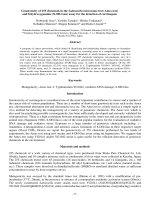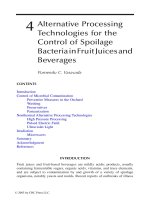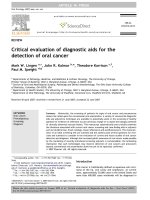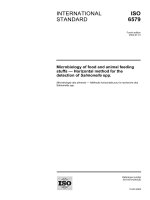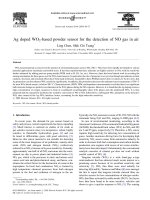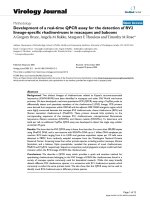- Trang chủ >>
- Khoa Học Tự Nhiên >>
- Vật lý
ag doped wo3-based powder sensor for the detection of no gas in air
Bạn đang xem bản rút gọn của tài liệu. Xem và tải ngay bản đầy đủ của tài liệu tại đây (308.88 KB, 8 trang )
Ag doped WO
3
-based powder sensor for the detection of NO gas in air
Ling Chen, Shik Chi Tsang
*
Surface and Catalysis Research Centre, University of Reading, Whiteknights, Reading RG6 6AD, UK
Received 21 August 2002; received in revised form 3 November 2002; accepted 11 November 2002
Abstract
WO
3
-based materials as sensors for the monitor of environmental gases such as NO
x
(NO NO
2
) have been rapidly developed for various
potential applications (stationary and mobile uses). It has been reported that these materials are highly sensitive to NO
x
with the sensitivity
further enhanced by adding precious group metals (PGM such as Pt, Pd, Au, etc.). However, there has been limited work in revealing the
sensing mechanism for these gases over the WO
3
-based sensors. In particular, the role of promoter is not yet clear though speculations on their
catalytic, electronic and structural effects have been made in the past. In parallel to these PGM promoters here we report, for the ®rst time, that
Ag promotion can also enhance WO
3
sensitivity signi®cantly. In addition, this promotion decreases the optimum sensor temperature of 300 8C
for most WO
3
-based sensors, to below 200 8C. Characterizations (XRD, TEM, and impedance measurement) reveal that there is no signi®cant
bulk structure change nor particle size alteration in the WO
3
phases during the NO exposure. However, it is found that the Ag doping creates a
high concentration of oxygen vacancies in form of coordinated crystallographic shear (CS) planes onto the underneath WO
3
. It is thus
proposed that the Ag particle facilitates the oxidative conversion of NO to NO
2
followed by a subsequent NO
2
adsorption on the defective
WO
x
sites created at the Ag±WO
3
interface; hence, accounting for the high molecular sensitivity.
# 2002 Elsevier Science B.V. All rights reserved.
Keywords: NO; Gas sensor; Sliver; WO
3
-based powder
1. Introduction
In recent years, the demand for gas sensors based on
safety and process control requirements has been expanding
[1]. Much interest is centered on studies of tin oxide as
gas sensitive resistors since it is inexpensive, robust, highly
sensitive to ¯ammable hydrocarbon gases [2] and can
be tuned to differentiate gases with good selectivity [3].
However, this sensor material is not suitable for detecting
some of the most dangerous of air pollutants, namely nitric
oxide (NO) and nitrogen dioxide (NO
2
) (collectively
referred to as NO
x
), because of its poor sensitivity. Currently,
approximately one-half of all NO
x
emissions into the envir-
onment are due to power plants and industrial boilers [4].
NO
x
gas, which is the precursor to nitric and nitrous acid,
causes acid rain and photochemical smog; and hence, con-
stitutes the critical factor for the destruction of ozone in the
troposphere. In fossil fuel combustion, NO
x
is formed by
high temperature chemical processes from both nitrogen
present in the fuel and oxidation of nitrogen in the air.
Typically, the NO
x
emissions consist of 90±95% NO with the
remainder being N
2
O and NO
2
ranging 0±4000 ppm [4,5].
In case of environmental monitoring, according to the
American Conference of Governmental Industrial Hygienist
(ACGIH), the threshold limit values (TLV) for NO
2
and NO
are 3 and 25 ppm, respectively [5]. Therefore, a NO
x
sensor
requires high sensitivity for detecting low concentration of
gases. Another enormous driving force for developing high
sensitivity NO
x
sensor comes from automotive industry. In
order to decrease both fuel consumption and carbon dioxide
production, new engines with excess of air versus stoichio-
metry have been developed. Unfortunately, the conventional
catalytic converter of exhaust gas does not work without
careful control of NO
x
[6].
Tungsten trioxide (WO
3
) is a wide band-gap n-type
semiconductor that has attracted much recent interest as a
promising sensor because of its excellent sensitivity and
selectivity [7].WO
3
thin ®lms were used initially for
detecting H
2
S and H
2
. Yamazoe and Miura [8] were amongst
the ®rst to report that tungsten trioxide sintered ®lms are
selective sensors for low concentrations of nitrogen oxides.
WO
3
thin ®lms activated by noble metals (Pd, Pt, Au) layers
have later been found to be more sensitive, selective and
shown to give a quicker response to NO
x
[5]. The sensing
Sensors and Actuators B 89 (2003) 68±75
*
Corresponding author. Tel.: 44-1189-316346;
fax: 44-1189-316632.
E-mail address: (S.C. Tsang).
0925-4005/02/$ ± see front matter # 2002 Elsevier Science B.V. All rights reserved.
PII: S 0 9 2 5 - 4005(02)00430-6
materials of WO
3
promoted with 1 wt.% metal or metal
oxides for NO detection were then systematically screened.
It was found that some of these promoters were critical for
improving the sensitivity [9].
The sensing mechanism of semiconductor oxides lie, in
general, on the changes in the resistance resulting from
physisorption, chemisorption, catalytic reactions and spe-
cies migration (spillover) on the promoter±sensor particles
upon analytical gas exposure [10]. It has been acknowledged
that the thin ®lm microstructure plays a major role in this
behavior [11,12]. This is mainly because grains and grain
boundary regions are expected to have signi®cantly different
electronic properties and, accordingly, to show a different
electronic response after the interaction with gases [11].
However, there is limited work reported in the literature on
addressing the precise sensing mechanism for the NO
x
gases
detection over WO
3
-based sensors and there is no work to
reveal the roles of the promoter. It is known that sensitivity
of NO
2
is many times higher than NO over the WO
3
-based
sensors and most of the best-reported promoters are also
known to be good oxidation catalysts. As a result, one of the
roles of promoter may be to provide a surface for the
catalytic conversion of NO to NO
2
that are responsible
for the high sensitivity associated with the promotion.
However, whether a speci®c interaction(s) between the
promoter and the WO
3
exists is not yet clear. In addition,
WO
3
phases generally regarded as distortions of the cubic
ReO
3
structure [13] are known to easily form non-stoichio-
metric oxides in which the oxidation state of the W is less
than 6 [14]. Their stability, relationship with promoter and to
the overall NO
x
sensing are still unclear.
In this paper, we report the screening of WO
3
powder
doped with different promoters as sensor candidates.
Amongst all the promoters tested, Ag/WO
3
shows the best
response to 50 ppm NO in air at the temperature range of
150±350 8C. It is found that the intrinsic high sensitivity of
Ag/WO
3
could not be mimicked via passing the same gas
mixture over a separate Ag/Al
2
O
3
bed (a good catalyst for
NO to NO
2
) prior to a pure WO
3
sensor arranged in series
under identical conditions. This suggests that Ag particles
supported on WO
3
not only provide NO
2
but also give some
kinds of bene®cial interfacial effects with the underneath
WO
3
. It is evident from the XRD and the TEM that the
Ag doping creates oxygen-de®cient sites that are believed to
be crucial for the enhanced sensitivity obtained over this
material.
2. Experimental
2.1. Sensor material preparation
Analytical grade WO
3
powder (Aldrich, 99.9%) was
purchased and used without further puri®cation. Doping
of WO
3
was achieved by mixing 1 wt.% precursors (soluble
salts) dissolved in a minimum amount of deionized water
(DI) with a dried WO
3
powder. The resulting mixture was
kept stirring at 80 8C until it was completely dried. All solids
were calcined at 600 8C for 2 h in air. The calcined powder,
0.6 g, was cold pressed at 10 tonnes into a pellet (area
1cm
2
) using an infra-red press.
2.2. Testing conditions
The sensor pellet was then sandwiched between two
platinum electrodes (Fig. 1), which were in turn connected
to an impedance analyzer (Solartron SI 1260) via two
jacketed co-axial cables. The electrical responses of the
sensor materials were measured in a ¯owing stream of pure
air or in 40 ppm NO in air (60:40 mixture from an air
cylinder with another cylinder (BOC special gases) contain-
ing ca. 100 ppm NO balanced with air) by the ac impedance
analyzer (Fig. 1). The ¯ow rate of the gases was kept at
100 ml/min throughout the measurement using mass ¯ow
controllers. The schematic diagram is presented below.
3. Results and discussion
3.1. Pure WO
3
Before conducting the screening 1% doped WO
3
sensors,
pure tungsten trioxide sensor pellet was initially tested for
the detection of NO in air in order to optimize acquisition
parameters. It was found that the resistance (collected from
the impedance at 0.5 Hz) of the material decreased at
increasing temperature, thus the observation is consistent
with the semiconducting behavior of the material. The
resistance of our WO
3
increased when the sensor was
exposed to NO gas in a similar way to WO
3
sensors reported
in [5,9,15].WO
3
is an n-type semiconductor, which means
that NO forms an anionic adsorbate on the surface of WO
3
particles under the present conditions. Although the material
responded almost instantaneously to the change of air to NO
gas, it required 20±30 min for the resistance to settle
(response time to reach steady state). This presumably is
the minimum time for the gas molecules to diffuse through
the compressed WO
3
powder with reference to this parti-
cular sensor con®guration (the gaseous molecules likely
Fig. 1. The apparatus for the sensing measurements.
L. Chen, S.C. Tsang / Sensors and Actuators B 89 (2003) 68±75 69
diffuse into the compressed powder through the edges of the
pellets). As a result, all data presented in this paper were then
collected at least 30 min after the gas exposure. It is inter-
esting to note from Table 1 that the sensitivity, S
(S resistance in NO/resistance in air) peaked at around
300 8C. This is in a good agreement with the optimum
temperature of around 300 8C reported in the literature using
WO
3
-based sensors [5,15]. It is accepted that lower sensi-
tivity is obtained at higher temperatures since the thermal
energy of the carrier (electrons) can overcome the charge
depletion layer in WO
3
. On the other hand, the poor sensi-
tivity at low temperature is related to the high activation
barrier for NO to form adsorbate on the oxide surface. As
typical of compressed powder, there are some variations in
the absolute response to the same gas mixture over different
sensors, but comparisons with different temperature, gas
composition, ¯ow, etc. can be reliably made by using the
same sensor [16]. As seen from Table 2, the optimum
sensitivity for 40 ppm NO in air using our pure WO
3
is
about S 9 Æ 2 collected at 300 8C. This value is slightly
higher than but comparable with the results presented by
Yamazoe and co-workers [15], who obtained S 4:6 using a
milled WO
3
powder sensor. It is noted that Penza et al. [5]
achieved S 4 using a WO
3
thin ®lm sensor and Tom-
chenko et al. [17] achieved S 1:5 using a WO
3
(Bi
2
O
3
)
thick ®lm sensor at 300 8C at atmosphere of 40 ppm NO in
air.
3.2. Screening 1% doped WO
3
sensors
After the ®rst report of using WO
3
-based sensor for NO
analysis, Yamazoe and co-workers [9] carried out extensive
screening of the WO
3
sensors doped with each of the 48
elements at 1% level. Elements such as Pb and Re were
shown to be exceptionally effective in enhancing the sensi-
tivity for NO gas. Penza et al. [5] reported the bene®cial
effect of doping (Pd, Pt, Au). It is noted that these dopants
are also known to be effective as NO oxidation catalysts. In
light of these works, here we investigated only doping with a
few elements to see the promotion effect (Pb, Ag, Sr, La).
Particular emphasis was on the effect of Ag since Ag/Al
2
O
3
is a well-accepted catalyst in the catalysis community for
NO conversion to NO
2
in air. As seen from Table 3, the
sensitivity is indeed enormously improved by doping the
WO
3
with silver giving S 21: 5. The order of effectiveness
of dopants is Ag @ Sr > Pb > La.
3.3. Ag doped WO
3
With regards to the signi®cant improvement in sensitivity
at 300 8C as the WO
3
is promoted with silver, it is interesting
to investigate whether this doped sensor gives the same
temperature response as the pure WO
3
(Table 1). Table 4
shows that the sensitivity of this sensor increases with
decreasing temperature (250 8C versus 300 and 350 8C).
This is interesting and may be important since this new
sensor offers lower operation temperature than most of the
reported WO
3
-based sensors. A sensitivity as high as 38.3
can be obtained at 250 8C over this Ag/WO
3
sensor as
compared to 2.8 without the Ag promotion (13.7 times
higher in sensitivity). There was no apparent change in
the time ($20±30 min) required to reach steady conditions
Table 1
Temperature effect for NO sensitivity
Temperature (8C) Sensitivity (5 min) Sensitivity (30 min)
250 1.8 2.8
300 7.1 10.0
350 3.0 5.0
Typical conditions: 0.6 g WO
3
compressed pellet in a flowing stream of
40 ppm NO in air at 100 ml/min.
Table 2
Variations over different WO
3
sensors using same experimental conditions
Temperature (8C) Sensitivity
300 11.1
300 10.0
300 9.6
300 9.1
300 6.8
Typical conditions: 0.6 g WO
3
compressed pellet in a flowing stream of
40 ppm NO in air at 100 ml/min.
Table 3
The sensitivity of doped materials
Entry Material Sensitivity
1WO
3
a
7.1
2 WO
3
b
10.6
3 Pb/WO
3
8.0
4 Ag/WO
3
21.5
5 Sr/WO
3
12.8
6 La/WO
3
3.9
Typical conditions: 0.6 g WO
3
-based compressed pellet in a flowing
stream of 40 ppm NO in air at 100 ml/min 8C at 300 8C. The powder
mixture was filtered, washed, dried and calcined at 600 8C for 2 h.
Characteristic FTIR bands confirmed the nature of theWO
3
.
a
Commercial WO
3
.
b
WO
3
prepared by a spray method using 4 g Na
2
WO
4
(Aldrich,
99.8%) pre-dissolved in 100 ml DM water, followed by spraying into a
6 M HCl solution with stirring at 80 8C.
Table 4
Sensitivity change of Ag doped WO
3
at different temperature
Temperature (8C) Sensitivity
250 38.3
300 21.5
350 8.8
Typical conditions: 0.6 g WO
3
compressed pellet in a flowing stream of
40 ppm NO in air at 100 ml/min.
70 L. Chen, S.C. Tsang / Sensors and Actuators B 89 (2003) 68±75
(rate of response) at different temperatures, which suggests
that the gas diffusion into the porous powder is not critically
dependent on the operation temperature but perhaps on the
¯ow characteristics/porosity within the powder. The sensi-
tivity enhancement with the decrease of optimum tempera-
ture for NO detection in air associated with the Ag doping
on WO
3
has not been reported before this present study.
However, Penza et al. [5] reported that noble metals (Pd,
Pt, Au) promotions to WO
3
give similar observations.
Typically, WO
3
promoted with Pd shifts the optimum tem-
perature from 300 to 200 8C with a four-fold sensitivity
increase (from S 4 to 16 for 40 ppm NO). It is noted that
these metal promoters including Ag are also well known to
be capable of catalyzing NO to NO
2
and NO
2
is known to
display a much higher molecular sensitivity than NO at the
same concentration.
Experiments were designed to investigate the role of Ag
particles on WO
3
. A catalyst of 2% Ag/Al
2
O
3
was synthe-
sized according to [18], which is ef®cient for the conversion
of NO to NO
2
in air. The material was sandwiched between
two silica wool plugs in a 5 cm in length, 4 mm i.d. vertical
Pyrex tube housed in a temperature controlled furnace.
Thus, this bed of 5 g of 2% Ag/Al
2
O
3
catalyst was inserted
between the gas supply and the pure WO
3
sensor. This setup
allowed the physical separation of the Ag from WO
3
with
different temperature controls. Fig. 2A shows clearly that
when the temperature of the Ag catalyst is increased to
250 8C, the sensitivity of the WO
3
sensor kept at 150 8C
increased by three times. Without heating the Ag catalyst or
bypassing the gas stream from the Ag catalyst bed no
sensitivity enhancement was encountered. Similar observa-
tion was obtained when the sensor was kept at 250 8C
(Fig. 2B). Although no attempt was carried out to monitor
the concentration of NO and NO
2
gases because of the low
concentration, one of the roles of the Ag is apparent to
provide surface for the conversion of NO to NO
2
according
to the literature [18]. It is worth noting that the sensitivity
enhancement (three to four times) for separate beds (Ag/
Al
2
O
3
WO
3
) is still far less than those observed using the
Ag doped WO
3
sensor (13.7 times) despite using a long
catalyst bed and/or a higher silver content. This indicates
that Ag doping onto the WO
3
may also provide a unique
interface for the interactions with NO
x
molecules.
3.4. Characterization of the sensor materials
Impedance analysis has been increasingly used to char-
acterize the inter-granular particles and interface phenom-
ena. It has been found that the simultaneous measurement of
resistance and capacitance of a specimen over a wide range
of frequency gives much more information than dc or a
single-frequency ac measurement [19,20]. Fig. 3 shows the
complex impedance spectra of 1% Ag/WO
3
at 350 8C in air
and in 40 ppm NO in air mixture, respectively. Both of
the impedance values (resistance at variable frequencies)
are found to depend on the input frequency, giving typical
Fig. 2. Histogram of NO sensitivity vs. Ag/Al
2
O
3
bed temperature. An increase in temperature of the Ag/Al
2
O
3
bed (production of NO
2
) results in the
increase in NO sensitivity over the WO
3
sensor.
Fig. 3. Complex impedance plots of Ag/WO
3
(with simulated RC elements) in air and in 40 ppm NO.
L. Chen, S.C. Tsang / Sensors and Actuators B 89 (2003) 68±75 71
semi-circle impedance spectra. Their simulated values using
equivalent circuitry with RC elements (C to mimic the
surface charge depletion layers on particle and between
particles, R granular and inter-granular resistance of the
sensor material in the parallel mode) are also presented in
Fig. 3.
It is interesting to note that when 40 ppm NO in air
mixture was passed over the sensor, the impedance of the
material was dramatically increased. In general, resistance
of WO
3
-based sensors reported in the literature increases
upon exposure to NO in air using dc measurement. It is
ascribed to the NO or NO
2
(product of NO oxidation over
metal doper) adsorption on WO
3
surface generating strongly
anionic adsorbates which create a large charge depletion
layer (increase in capacitance) to restrict the dc current ¯ow
[15]. It is noted however, our simulation results indicate that
the capacitance and the contact resistance (Ra) of the Ag/
WO
3
were only marginally altered to a small extent but the
main change was in its granular/inter-granular resistance.
Thus, it is likely that adsorption of these gases may somehow
interfere with the main pathway for a current ¯ow through
the sensor particles in this particular sensor. Studies of
electrical conductivity of WO
3
have been extensively carried
out in the past. It is generally accepted that the electrical
conductivity of WO
3
depends critically on its stoichiometry
and particularly the presence of oxygen vacancies in WO
3
.
Electrical conductivity increases at higher defect concentra-
tion [21,22]. Thus, NO
x
adsorption on these oxygen-de®-
cient W sites blocking the current passage through the
material is therefore envisaged.
3.4.1. X-ray diffraction (XRD)
XRD analyses of this sensor material were carried out
using a Spectrolab Series 1300 CPS 120 X-ray powder
diffractometer equipped with a capillary sample holder.
The data were collected in Debye±Scherrer geometry using
a monochromated X-ray beam of nickel ®ltered Cu Ka
radiation (l 0:154 nm). This was obtained from a curved
Fig. 4. XRD spectra of WO
3
before and after the NO exposure.
Fig. 5. XRD spectra of 1% Ag/WO
3
before and after the NO exposure.
72 L. Chen, S.C. Tsang / Sensors and Actuators B 89 (2003) 68±75
quartz monochromatic crystal. The X-ray beam was passed
through the capillary, which contained the sample and was
then diffracted onto the detector. The detector collected data
for all angles in the range 4±648,2y, simultaneously.
Fig. 4 gives the diffraction spectra of the WO
3
before and
after the NO exposure, which shows a triclinic polycrystal-
line structure matching most of the major peaks collected.
From Fig. 4, we can see that the (0 0 1) peak has the highest
intensity. The lattice constants of the WO
3
were computed to
be a 7:311(2) A
Ê
, b 7:512(3) A
Ê
, c 3:846(2) A
Ê
. These
values and their relative intensities match very well with
those given by the JCPDS ®le no. 20±1323 (a 7:300 A
Ê
,
b 7:520 A
Ê
, c 3:845 A
Ê
) for triclinic WO
3
. It was
observed that there is no new peak or any peak shift before
or after the NO treatment. This suggests that the crystal
structures were identical throughout the sensing. It is noted
that this observation is in an agreement with the previous
report [19] that revealed no bulk structural change in the
WO
3
after its exposure to NO gas in air.
In contrast, it is interesting to ®nd that there is a very low
but clearly observable diffraction hump at the 2y angle
between 10 and 188 in the 1% Ag/WO
3
sample (Fig. 5).
Such low angles do not match with any possible diffrac-
tion peaks from silver or possible compounds (in fact, no
peaks can be assigned to Ag at this doping level) but merely
re¯ect some local orders with relatively large lattice para-
meters. WO
3
is easy to form local non-stochiometric
regions, especially oxygen de®ciency in WO
3
can generate
crystallographic shear (CS) structures giving a wide range of
local non-stoichiometry of WO
3Àx
[23]. Detailed XRD char-
acterizations of intermediate phases of W
5
O
14
,W
18
O
49
and
W
20
O
58
derived from the parent WO
3
with long-range order
structures have been reported [24]. It is therefore speculated
that silver doping might have introduced some degree of local
order non-stoichiometry structure in the sensor material.
However, identi®cation of this phase(s) by XRD in the
background of WO
3
was proved to be very dif®cult because
of the low concentration and the poor diffraction region. It is
noted however, that the well-characterized W
5
O
14
phases
Fig. 6. A low-resolution TEM micrograph showing the 1 wt.% doped
WO
3
material after the NO exposure (magnification 152,000Â showing
average particle size of 300 nm).
Fig. 7. A high-resolution TEM micrograph and a model showing that the 1 wt.% doped WO
3
material after the NO exposure generates a high concentration
of local ordered CS structures.
L. Chen, S.C. Tsang / Sensors and Actuators B 89 (2003) 68±75 73
show a maximum peak value at 2y of 148 [24] which ®ts
coincidentally into the hump region of our XRD.
3.4.2. Transmission electron microscopy (TEM)
TEM experiments were carried out using a Phillips CM
20, 200 kV (0.26 nm point resolution) under bright ®eld
conditions. It was shown from Fig. 6 that the average particle
size of the 1% Ag/WO
3
-based material before or after test is
about 300 nm in diameter. There was no obvious change in
particle size and morphology after this material was
quenched from 40 ppm NO in air during the sensing.
Fig. 7 shows the high-resolution TEM images of 1% Ag/
WO
3
which revealed high concentration of the defective
regions (enriched with CS structure at [0 1 0] with respect to
[0 0 1] WO
3
). It is found that the separation of these
defective lines is not always identical re¯ecting their lack
of a long-range order (non-stoichiometry region of disorder
nature). However, some local regions show ordered patterns
(the lack of their long-range order and their heterogeneity
may explain the poor re¯ection hump obtained in XRD).
Typically, as seen in the ®gure, a region containing ca.
6.93 A
Ê
inter-planar separation can be visualized. It is inter-
esting to note that these defective lines in WO
3
are much
easily found in the regions at a close proximity to the Ag
particles (at or near to surface). The reason for the creation of
CS defects associated with Ag doping is not yet known. So
far, there is no evidence that Ag atoms are incorporated into
these local ordered defective structures (from XRD,
HRTEM). It is however, interesting to point out that silver
nanoparticle, upon melting, can absorb a large amount of
oxygen from environment (reaching about 10 times its
volume, or 0.3% of its weight in oxygen). On cooling to
a few degrees above solidi®cation, it abruptly releases much
of its oxygen adsorbed in a dramatic phenomenon known as
`spit' [25]. There are many recent studies on catalytic
oxidation using supported silver nanoparticles based upon
these interesting properties. Thus, when the Ag particles are
in a close contact with WO
3
, it is likely that oxygen
migration between the silver nanoparticles and the WO
3
support is involved. The phenomenon of metal±oxide sup-
port interaction and the implications on catalysis are cur-
rently being explored in copper, silver or gold on oxide
supports [26].
4. Conclusion
Initial development of NO sensor to monitor NO gas in air
based on WO
3
is presented here. As far as we are aware, 1%
Ag promotion to WO
3
is for the ®rst time disclosed in the
open literature. Thus, the Ag promotion can dramatically
enhance sensitivity and decrease the optimum sensor tem-
perature of the compressed WO
3
powder sensor. Attempts to
understand the bene®cial effects of Ag have been carried
out. It is evident that Ag surface can oxidize NO to NO
2
that
shows a high molecular response (sensitivity) to WO
3
-based
materials. Thus, one of the roles of Ag promotion is to
provide metal surface for the NO conversion to NO
2
.Itis
however, also found that small silver particles residented on
WO
3
produce a much higher sensitivity than those using two
separate beds (Ag/Al
2
O
3
and WO
3
). This result indicates a
structural synergy between silver and WO
3
(metal±support
interaction) for optimum sensitivity. Impedance measure-
ment suggests that adsorption of NO
x
, possibly takes place
on the oxygen defective WO
3Àx
sites; hence, interrupting
this main electrical conductive pathway of the material.
Thus, other roles of Ag promotion may include creation
of these defective sites on the WO
3
at and near the interface
between the small Ag particles and the bulk WO
3
particles as
indicated by the present XRD and the TEM results. A
detailed study on the WO
3
promoted at different Ag loadings
will be very useful in correlating the active sites (created at
the Ag±WO
3
interface) with the sensing sensitivity, which is
being carried out at the present laboratory.
References
[1] S.C. Tsang, C. Bulpitt, Rare earth oxide sensors for ethanol analysis,
Sens. Actuators, B, Chem. 52 (1998) 226±235.
[2] T. Seiyama, A. Kato, K. Fujiishi, M. Nagatani, Anal. Chem. 34
(1962) 1502.
[3] C. Bulpitt, S.C. Tsang, Detection and differentiation of C
4
hydrocarbon isomers over the Pd±SnO
2
compressed powder sensor,
Sens. Actuators, B, Chem. 69 (2000) 100±107.
[4] B.T. Marquis, J.F. Vetelino, A semiconducting metal oxide sensor
array for the detection of NO
x
and NH
3
, Sens. Actuators, B, Chem.
77 (2001) 100±110.
[5] M. Penza, C. Martucci, G. Cassano, NO
x
gas sensing characteristics
of WO
3
thin films activated by noble metal (Pd, Pt, Au) layers, Sens.
Actuators, B, Chem. 50 (1998) 52±59.
[6] F. Me
Â
nil, V. Coillard, C. Lucat, Critical review of nitrogen monoxide
sensors for exhaust gases of lean burn engines, Sens. Actuators, B,
Chem. 67 (2000) 1±23.
[7] S.C. Moulzolf, S. Ding, R.J. Lad, Stoichiometry and microstructure
effects on tungsten oxide chemiresistive films, Sens. Actuators, B,
Chem. 77 (2001) 375±382.
[8] N. Yamazoe, N. Miura, New approaches in the design of gas sensors,
in: G. Sberveglieri (Ed.), Gas Sensor, Kluwer, Dordrecht, The
Netherlands, 1992, Chapter 1, pp. 1±42.
[9] X. Wang, N. Miura, N. Yamazoe, Study of WO
3
-based sensing
materials for NH
3
and NO detection, Sens. Actuators, B, Chem. 66
(2000) 74±76.
[10] S.C. Tsang, C.D.A. Bulpitt, P.C.H. Mitchell, A.J. Ramirez-Cuesta,
Some new insights into the sensing mechanism of palladium
promoted tin(IV) oxide, J. Phys. Chem. B 105 (2001) 5737±5742.
[11] W. Go
È
pel, K.D. Schierbaum, NO
2
sensors-current status and future-
prospects, Sens. Actuators, B, Chem. 26 (1995) 1±12.
[12] C.N. Xu, J. Tamaki, N. Miura, N. Yamazoe, Grain-size effects on gas
sensitivity of porous SNO
2
-based elements, Sens. Actuators, B,
Chem. 3 (1991) 147±155.
[13] A.S. Wells, Structural Inorganic Chemistry, Oxford Science
Publications, Oxford, 1987, pp. 569±574.
[14] G. Sberveglieri, L. Depero, S. Groppelli, P. Nelli, WO
3
sputtered thin
films for NO
x
monitoring, Sens. Actuators, B, Chem. 26/27 (1995)
89±92.
[15] M. Akiyama, J. Tamaki, N. Miura, N. Yamazoe, Tungsten oxide-
based semiconductor sensor highly sensitive to NO and NO
2
, Chem.
Lett. (1991) 1611±1614.
74 L. Chen, S.C. Tsang / Sensors and Actuators B 89 (2003) 68±75
[16] S. Morrison, M. Madou, Chemical Sensing with Solid State Devices,
Academic Press, Boston, 1989.
[17] A.A. Tomchenko, V.V. Khatko, I.L. Emelianov, WO
3
thick-film gas
sensors, Sens. Actuators, B, Chem. 46 (1998) 8±14.
[18] N. Bogdanchilova, FC. Meunier, M. Avalos-Borja, J.P. Breen, A.
Pestryakov, On the nature of the silver phases of Ag/Al
2
O
3
catalysts
for reactions involving nitric oxide, Appl. Catal., B, Environ. 36 (4)
(2002) 287±297.
[19] T. Ishihara, H. Fujita, Y. Takita, Effects of Pt addition for SrSnO
3
-
WO
3
capacitive type sensor on NO detection at high temperature,
Sens. Actuators, B, Chem. 52 (1998) 100±106.
[20] W.B. Johnson, W.L. Worrell, in: J.R. Macdonald (Ed.), Impedance
Spectroscopy, Wiley, New York, 1987, 238 pp.
[21] S.C. Moulzolf, L.J. Legore, R.J. Lad, Heteroepitaxial growth of
tungsten oxide films on sapphire for chemical gas sensors, Thin Solid
Films 400 (1/2) (2001) 56±63.
[22] H. Hosono, M. Miyakawa, H. Kawazoe, K. Shimizu, Formation of
electronic conducting amorphous WO
3
thin films by ion implanta-
tion, J. Non-Cryst. Solids 241 (2/3) (1998) 190.
[23] J.S. Anderson, R.J.D. Tilley, in: M.W. Roberts, J.M. Thomas (Eds.),
Surface and Defect Properties of Solid, vol. 3, The Chemical Society,
London, 1974.
[24] G.L.F. Rey, A. Rothschild, J. Sloan, R. Rosentsveig, R. Popovitz-
Biro, R. Tenne, Investigations of nonstoichiometric tungsten oxide
nanoparticles, J. Solid State Chem. 162 (2001) 300±314.
[25] R.L. Davies, S.F. Etris, The development and functions of silver in
water purification and disease control, Catal. Today 36 (1997) 107±
114.
[26] M. Haruta, Y. Souma (Eds.), Copper, silver and gold in catalysis,
Catal. Today, vol. 36, no.1, Elsevier, 1997.
Biographies
Ling Chen received a BSc degree in chemistry at Guangxi Teachers
College, China in 1995. She is currently completing her postgraduate
course under the supervision of Dr. Tsang in the Catalysis Research Centre
at Reading. Her research was concerned with solid state sensors and
catalysis.
Shik Chi Tsang obtained a first class degree in chemistry from Birbeck
College, London University in 1987. He received his PhD from Reading
University in 1991. After spending 4 years as a departmental research
fellow in the Inorganic Chemistry Laboratory at Oxford University, he
returned to Reading in 1995. Dr. Tsang currently holds a readership at
Reading University and a Royal Society University Fellowship for
catalysis research. His main research interests are catalysis, mesoporous
materials, supercritical CO
2
and sensors.
L. Chen, S.C. Tsang / Sensors and Actuators B 89 (2003) 68±75 75

